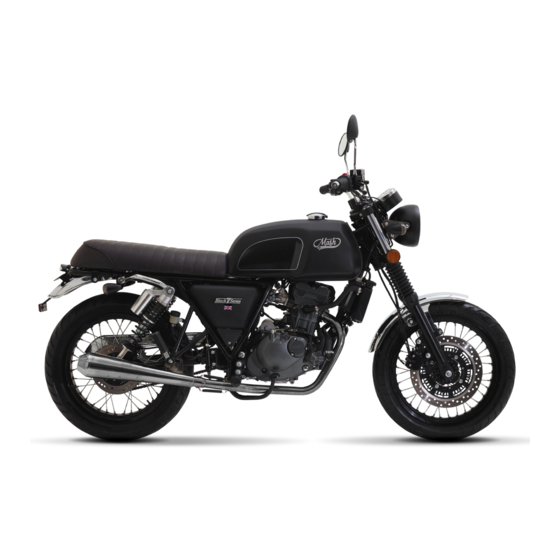
Table of Contents
Advertisement
Advertisement
Table of Contents
Troubleshooting

Summarization of Contents
Specifications
Mash Seventy Five 125cc
Technical specifications for the Mash Seventy Five 125cc model.
Mash Café Racer 125cc
Technical specifications for the Mash Café Racer 125cc model.
Mash Black Seven 125cc
Technical specifications for the Mash Black Seven 125cc model.
User Instructions and Riding Safety
Safe Riding Practices
Guidelines for safe motorcycle riding, including gear, speed, and awareness.
Serial Number Identification
Location and importance of chassis and engine serial numbers for registration and parts.
Motorcycle Components and Controls Overview
Handlebar Instruments and Controls
Identification of instruments and controls on the handlebars, including speedometer and indicators.
Motorcycle Left Side Components
Key components located on the left side of the motorcycle, such as the front wheel and injector.
Motorcycle Right Side Components
Key components located on the right side of the motorcycle, like the spark plug and battery box.
Controls and Instrumentation Details
Instrumental Panel
Detailed description of the motorcycle's instrumental panel, indicators, and meters.
Ignition Switch Operation
Explanation of the ignition switch positions: OFF, ON, Handlebar Lock, and Night Parking.
Left Handlebar Control System
Operation of clutch lever, hi/lo headlight switch, and turn signal switch.
Right Handlebar Control System
Operation of horn button, engine shutdown switch, front brake lever, and electric start.
Motorcycle Operation and Components
Accelerator Grip Function
How to use the accelerator grip to control engine speed and decelerate.
Fuel Tank Cap and Gear Lever
Procedures for opening the fuel tank cap and operating the 5-speed gear lever.
Rear Brake Pedal and Side Stand
Using the rear brake pedal and deploying/retracting the side stand.
Rear Shock Damper Adjustment
Adjusting the spring tension of the rear shock absorbers for different conditions.
Fuel and Lubricant Recommendations
Fuel Recommendations
Guidelines on using unleaded gasoline 95 or 98, and avoiding SP95 E10.
Lubricant Recommendations
Recommended engine oils, viscosity grades, and replacement intervals for optimal engine life.
New Motorcycle Running-In Procedures
Running-In Speed Limits
Recommended speed limits for the first 800 km and up to 1600 km.
Engine Speed Variation
Importance of varying engine speed to ensure proper break-in of engine parts.
First Maintenance Inspection
The critical importance of the first service at 1000 km for engine longevity.
Pre-Ride Inspections
Steering and Lighting Inspection
Checking steering handlebar for looseness and operating all lights.
Brake System Inspection
Verifying brake pedal clearance, feel, and checking for leaks.
Tire, Fluid, and Indicator Checks
Inspecting tire pressure, tread, transmission oil, and indicators.
Clutch, Accelerator, and Chain Checks
Checking clutch free play, accelerator return, and driving chain condition.
Motorcycle Driving Essentials
Safe Driving Precautions
Advice on practicing, handling, road conditions, and traffic laws.
Engine Starting Procedure
Step-by-step guide for safely starting the motorcycle engine.
Starting to Drive the Motorcycle
How to engage gears, use the accelerator, and slow down safely.
Maintenance Schedule and Procedures
Regular Maintenance Intervals
Schedule of regular maintenance tasks based on mileage and time intervals.
Lubrication Schedule and Tools
Lubrication requirements for various parts and identification of the tool kit.
Spark Plug Maintenance
Procedures for cleaning, adjusting gap, and replacing the spark plug.
Engine Oil and Filter Replacement
How to check engine oil level and the process for replacing oil and filter.
Brake System Maintenance
Disc Brakes and CBS System
Information on disc brakes, the CBS system, and front brake checks.
Brake Fluid and Pad Maintenance
Checking brake fluid level, type, and wear of brake pads.
Rear Brake Adjustment
Adjusting the rear brake pedal position and the brake light switch.
Other Component Maintenance
Silencer and Fuse Box
Information on the motorcycle silencer and the location and function of the fuse box.
Bulb Replacement and Air Filter Servicing
Guidelines for replacing bulbs and cleaning or replacing the air filter element.
Electronic Fuel Injection (EFI) System
Overview of the EFI system and when to consult a dealer for diagnostics.
Adjustments and Chain Maintenance
Throttle and Clutch Cable Adjustments
How to adjust the free play in the throttle and clutch cables.
Driving Chain Adjustment and Cleaning
Procedure for adjusting chain tension and cleaning/lubricating the driving chain.
Tire Maintenance and Pressure
Tire Pressure and Wear
Importance of correct tire pressure and checking tread depth for safety.
Tire Inflation and Type
Recommended tire inflation pressures and using standard tire types.
Measures to Reduce Pollution
Fuel Use for Pollution Control
Recommendations on fuel types to reduce exhaust emissions and pollution.
Riding Practices for Pollution Control
Riding sensibly to minimize noise and exhaust pollution.
Troubleshooting Engine Issues
Engine Starting Troubleshooting
Steps to diagnose and resolve issues when the engine fails to start.
Engine Stalling and Abnormal Operation
Troubleshooting common problems like engine stalling, noise, and overheating.
Motorcycle Storage Procedures
Motorcycle Storage Preparation
Steps for preparing the motorcycle for long-term storage, including cleaning and fuel.
Returning Stored Motorcycle to Service
Procedures for taking a stored motorcycle back into use, including checks and lubrication.













Need help?
Do you have a question about the Cafe Racer and is the answer not in the manual?
Questions and answers